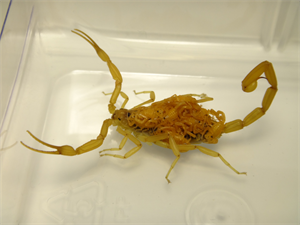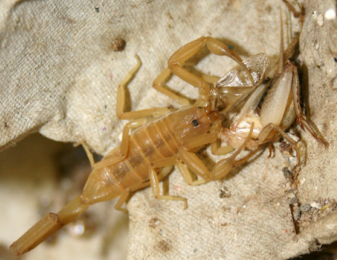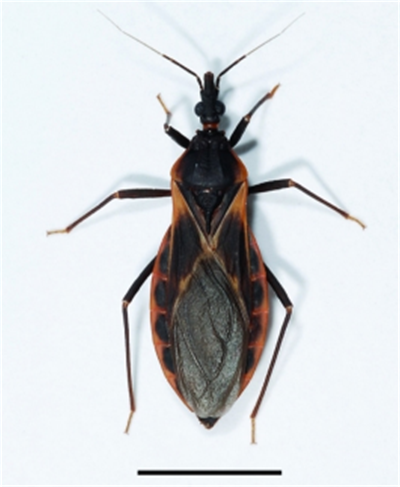
Please take this short 5-question survey about our newsletter:
https://uarizona.co1.qualtrics.com/jfe/form/SV_cMhZ82JodDKJgCa
As the weather warms up, we have already started receiving enquiries about scorpions and kissing bugs. This newsletter will highlight two of our publications about these fascinating, yet dreaded arthropods.


Figure 1 (left). Arizona bark scorpion. Photo: David S. Flores; Figure 2 (right). Conenose (kissing) bug.
Photo: Miguel Francisco Enriquez Galaz.
Dawn H. Gouge, Shujuan (Lucy) Li, Christopher Bibbs, and Shaku Nair
Scorpions are predatory arachnids related to spiders, mites, and ticks. They are some of the oldest known terrestrial arthropods (animals with an external skeleton, a segmented body, and paired jointed limbs). Scorpions have an elongated body and a segmented tail that ends in a stinger that can deliver a venomous sting. They have four pairs of legs and pedipalps with plier-like pincers on the end, used for grasping (Figure 1).
There are close to 2,000 described species of scorpions worldwide, at least 100 in the U.S., and more than 50 species in the desert southwestern states. Scorpions have long been of concern and interest to humans primarily due to their ability to give painful, and sometimes life-threatening stings, but also because they are important and beneficial components of many ecosystems.
Our Most Venomous Species, the Arizona Bark Scorpion
The Arizona bark scorpion is typically associated with “crevice” harborage during daylight hours. They are found in walls, and under rocks, logs, tree bark, and other surface objects. They may also be found in small animal burrows and other protected places, including inside building wall voids. In fact, the Arizona bark scorpion is common around buildings of all kinds in low desert areas and is often associated with homes and hollow block perimeter walls. The scorpions live for 5-7 years feeding on crickets (Figure 3), cockroaches and many other insects, and can be seen drinking from small pools of standing water.

Figure 3. Arizona bark scorpion feeding on a cricket. Photo: Melissa Sikes.
Arizona bark scorpions are not territorial, and are usually found living with others, sometimes in dense populations if resources are plentiful. Homes and buildings with irrigated landscapes can support healthy populations much higher than in desert wild-land areas. Around buildings, they usually go undetected unless they gain access to the interior of buildings. They enter under and around poorly fitted doorways (Figure 4), through window vents, and under exterior walls with openings, and even via weepholes in the weep screed (which allows water to exit from wall voids).
Once inside walls, they can easily move throughout the envelop of a building and access interior spaces around electrical faceplates (Figure 5), pipe collars, etc. Arizona bark scorpions are proficient climbers, and will make their way across interior flooring, scale walls and traverse across ceilings. Scorpions may fall from ceilings, landing in beds, sinks, bathtubs, toilet bowls, etc. If you find a scorpion in a pool or spa, do not assume it is dead or unable to sting. They can remain alive entirely submerged for surprising amounts of time in chlorinated pool water, and recover well enough to defend themselves if fished out by hand.

Figure 4. Arizona bark scorpion entering through gap under a door. Photo: Chloe Fung.

Figure 5. Once inside a wall void, bark scorpions can enter a home interior in many ways. Photo: Chloe Fung.
Arizona bark scorpions are active for most of the year in low desert areas, and nighttime temperatures above 70° F are ideal. During the coolest months (November-March) they are less active, and during the coldest periods they cluster as groups in weather protected, enclosed, and undisturbed spaces called “hibernacula”. Groups may be found when residents undertake construction work during the winter months and block walls are removed, or building walls are opened up during remodeling efforts.
In research studies investigating the harborage preferences of Arizona bark scorpions, 95% of the scorpions preferred hollow block walls as refuge places compared with the many other options around buildings and landscapes. Vegetation (including tree bark and pine cones), ground cover, and underground burrows are also used as harborage by the scorpions, but hollow block walls are preferred.
The Sting
All scorpions will sting to defend themselves, and the majority of sting incidents occur when a scorpion is accidentally grabbed, crushed against the body, or trodden on.
The Arizona bark scorpion is the only scorpion species of medical significance in the United States. However, a sting is not likely to be fatal, or cause long-term injury as long as medical treatment for infants and children is immediately acquired.
If you are stung by a scorpion and are concerned about your symptoms, call the Poison Help Hotline at 1 (800) 222-1222, contact a medical professional or go to an emergency room.
Living With and Managing Scorpions
In the desert southwest, we share our space with the medically important Arizona bark scorpion, and our homes provide these amazing and adaptable scorpions with plentiful food, water, and shelter. To eliminate scorpions from our landscapes would require extremely unhealthy and illegal chemical use that would at best, be a temporary eradication of the pest. A far healthier and sustainable approach is to accept that scorpions are part of the natural landscape, and take precautions to exclude the creatures from the interior of homes and buildings.
The following are useful tips for the safe and harmonious sharing of our incredible desert landscape.
Scorpions are extremely difficult to eradicate. If you regularly find scorpions inside your home, call a pest management professional experienced in the management of scorpions. Eliminating their food sources (crickets and other insects) can help, but will not eliminate scorpions from around the home. If a reduced scorpion population is desirable, additional steps can be taken. However, scorpions are difficult to manage with pesticides alone. Pest-proofing your home or structure is by far the most effective way to reduce scorpion contact and potential scorpion stings.
Read more about different species of scorpions, their biology, behavior and management in our publication linked here:
https://extension.arizona.edu/sites/extension.arizona.edu/files/pubs/az1768-2018.pdf
Shujuan (Lucy) Li, Dawn H. Gouge, Irene Ruberto, Shaku Nair, Alfred J. Fournier, Wesley E. Hall
Kissing bugs (also known as conenose bugs) are large, dark brown or black true bugs, belonging in the insect Order Hemiptera. Some species have patterns and markings on their abdomen, which vary by species. As adults they range in size from 0.5 to over 1 inch (13.0 to 33.0 mm) in length. Kissing bugs get their name because these insects often bite people while they are sleeping, and often bite around the mouth or on the face. They are also known as triatomine bugs, conenose bugs, and Hualapai (or Wallapai) tigers.
There are 11 species of kissing bugs in the U.S., of which seven species in the genera Triatoma and Paratriatoma are found in Arizona. The most troublesome and numerous species associated with human dwellings in Arizona are: T. rubida (Figure 6), T. protracta and T. recurva.

Figure 6. Adult female Triatoma rubida – the most abundant species of kissing bugs in Arizona.Photo: Charles Hedgcock. (Scale bar = 1 cm).
Kissing bugs usually live outdoors and are often associated with the nests of Neotoma woodrat species (also called pack rats) and other wildlife. However, they can also be associated with domesticated animals, and often found in the bedding of outdoor doghouses and chicken coops. Adults fly well and are attracted to lights after dark. In suburban and rural Arizona, kissing bugs are often attracted to porch lights. At dawn, they may seek a way to avoid sunlight and heat, and may enter a residence through a doorway gap, or cracks around window screens. They also enter homes by moving up from crawlspaces beneath flooring, or hitchhike on pets. Once inside, they move toward areas of low light intensity, hiding in and under furniture (between mattresses is a favorite hiding place) and in closets during the daytime hours. Adult kissing bugs are most commonly encountered during their dispersal season, May through July, when they fly towards homes attracted by lighting. Some species actively seek out humans and domestic animals to feed on. They are attracted to the gases we exhale, skin odors, and to the warmth of our bodies. Feeding occurs mainly at night, after which they tend to move away from the host. Engorged bugs are often found amongst bedding and drapes close to the bed in the morning.
Kissing bugs rapidly suck blood within 10 to 30 minutes. Fully engorged bugs can take one to five times their weight in blood, and the bugs will feed about every one to two weeks when hosts are available, and temperatures are warm. Adults live into mid- to late autumn. Kissing bugs overwinter as developing nymphs and molt into adults in spring. Females can lay up to several hundred eggs over their lifespan depending upon conditions. Active dispersal is achieved by flight in adults, usually around dusk and early evening. Immature kissing bugs cannot fly but crawl to find a blood source.
Kissing Bug Bites and Health Concerns
1. Chagas Disease (acute and chronic phases, see: https://www.cdc.gov/parasites/chagas/disease.html)
In parts of southern and central South America, kissing bugs are the primary vectors of the parasite Trypanosoma cruzi that causes Chagas disease. Chagas is a severe, often chronic, and sometimes lethal disease. Unlike mosquito and tick vectored pathogens, the kissing bug bite does not transmit the parasite. The T. cruzi protozoan is transmitted in kissing bug feces, which may be scratched into the bite wound, ingested, or accidentally rubbed by the host into moist tissues around the eyes, nose, and mouth. Incidence of Chagas disease is low in the U.S., even though many species of kissing bugs carry T. cruzi in their gut. Researchers attribute the low incidence of Chagas disease in the continental U.S. to poor efficacy of protozoan transmission by the bugs, infrequent human contact, and poor ability of the bugs to permanently colonize homes. Studies have shown that over 40% of the kissing bugs around Tucson, Arizona carry the parasite, but it is very rare for these bugs to transmit the disease to people. Evidence of Arizona residents acquiring T. cruzi from Arizona kissing bugs (called autochthonous transmission) is rare. However, overall risk in the U.S. is undefined and reporting suspected cases will aid surveillance efforts. Chagas cases have been increasing in the U.S., Canada, some European, and Western Pacific countries. This could be due in part to increased population mobility between Latin America where the disease is endemic, and the rest of the world.
2. Bug bite and possible allergic reactions (not parasite infection related)
Kissing bug bites usually occur at night, and may be single or grouped on the face, neck, arms, legs, and sometimes on the chest or other body parts. Bites are initially painless because the insect saliva contains an anesthetic, but might soon itch, swell, and cause a substantial welt that can last for several days. More severe reactions range from huge, painful welts to allergic reactions, that may become severe generating difficult breathing, low blood pressure, and rapid heart rates due to anaphylaxis. Kissing bug bites can be confused with bites from other pests such as mosquitoes or bed bugs because the reactions can look similar. Though the bites are generally painless, they can cause intense itching and tenderness at the bite site, which can become swollen and reddish to purple. The irritation may last one to two weeks, but sensitive individuals may experience more severe or prolonged reactions. With multiple subsequent bites, anaphylaxis may occur and may be potentially life threatening.
Individuals who experience an allergic reaction should seek immediate If you are bitten by a kissing bug, you should clean the bite site with soap and water. Oral antihistamines like diphenhydramine (e.g., Benadryl), topically applied 3-4% ammonia solution, and bathing in an epsom salt solution may help control itching. Severe reactions require medical treatment. Bites cannot be identified in the absence of an insect. If you find the bug, collect the specimen and put it in a container to take with you when seeking medical attention. Emergency allergy kits are often prescribed for patients who suffer severe reactions to use in case of future bites.
Pest-Proofing Your Home is the Best Preventative Measure Against Kissing Bug Bites
Reduce the number of kissing bugs present in and around the home by:
Read more about the different species of kissing bugs, their biology and behavior and health concerns due to their bites in our publication linked here: https://extension.arizona.edu/sites/extension.arizona.edu/files/pubs/az1992-2022.pdf
https://extension.arizona.edu/sites/extension.arizona.edu/files/pubs/az1677-2015.pdf
Did you know we spend about 90% of our time indoors? Indoor Air Quality (IAQ) affects everyone, especially the most vulnerable - children, the elderly, and people with health conditions like asthma and heart disease.
The US EPA has resources providing information about the most common types of IAQ concerns, and the steps you can take to address them.

Identify this common weed.
Answer: Sowthistle Sonchus spp. Sowthistles are often confused with dandelions, and they certainly have some similarities, especially in the early stages of growth. Check out the following link to read more about both these common weeds. https://www.botanical-online.com/en/botany/dandelion-sowthistles-differences
Congratulations to Master Pest Detectives: Rita Bricker, Pinal Co. MG, and Nancy Parks.

If you know the answer, email Dawn at dhgouge@arizona.edu. You will not win anything if you are correct, but you will be listed as a “Master Pest Detective” in the next newsletter issue.
https://uarizona.co1.qualtrics.com/jfe/form/SV_cMhZ82JodDKJgCa

In-person April 23-24, 2024
Online April 29 – May 31, 2024
The Arizona School IPM Conference is a great opportunity for continuing education for all institutional staff engaged in operations, maintenance, turf and landscape, food service, health services and more, in schools, childcare, community colleges, public health, medical facilities, city parks and rec, turf and landscape and many other areas.
Direct links for tickets:
Conference information: https://acis.cals.arizona.edu/community-ipm/events/arizona-school-ipm-conference
For paper registration using check/Purchase Order, please email nairs@arizona.edu.
Email nairs@arizona.edu if you have questions.
____________________________________________________________

MAY 10, 2024
(In-person only)
EL CONQUISTADOR HOTEL, TUCSON
Registration and Conference Information at Front | Desert Horticulture Conference (arizona.edu)
____________________________________________________________
Upcoming webinar offering AZ Credits: Fungal Disease Management for Ornamental Plants. May 7, 2024 | 2:00-3:30 PM ET. Approved for 1.5 Arizona AG Credits.
Fungal pathogens are imported into the U.S. on ornamental plants with regularity. These pathogens can have significant impacts on the ornamental plant and landscape industries. In this webinar, participants will receive an introduction to common fungal diseases of ornamental plants and their prevention and management. The origins of fungal pathogens on imported plants, their identification, as well as the causes of occurrences with plant production facilities will be discussed. Our expert will describe the importance of Integrated Pest Management, including the role of cultural practices, non-chemical controls, and the selective use of fungicides. Highlights of current research and practical control experiences will be shared.
Register here: https://attendee.gotowebinar.com/register/3726637867889702232
View recordings of archived EPA Integrated Pest Management Webinars at https://www.epa.gov/managing-pests-schools/upcoming-integrated-pest-management-webinars.
For more information about the EPA Schools program: http://www.epa.gov/schools/
____________________________________________________________
Urban and Community IPM Webinars University of California
UC Statewide IPM Program Urban and Community webinar series is held the third Thursday of every month to teach about pest identification, prevention and management around the home and garden. This series is free but advanced registration is required. Dates and topics below, all begin at noon Pacific. https://ucanr.edu/sites/ucipm-community-webinars/
___________________________________________________________
What’s Bugging You? First Friday Events (New York State IPM Program)
Fridays | 12:00 pm. – 12:30 p.m. EDT | Zoom | Free; registration required
In this monthly virtual series, we explore timely topics to help you use integrated pest management (IPM) to avoid pest problems and promote a healthy environment where you live, work, learn and play. What is IPM? It's a wholistic approach that uses different tools and practices to not only reduce pest problems, but to also address the reasons why pests are there in the first place. Each month, our speakers will share practical information about how you can use IPM. Register for upcoming events.
What’s Bugging You First Friday events are also available in Spanish. Individuals interested in these events can find more information on this website: https://cals.cornell.edu/new-york-state-integrated-pest-management/outreach-education/events/whats-bugging-you-webinars/conozca-su-plaga___________________________________________________________
To view previous University of Arizona newsletters, visit: https://acis.cals.arizona.edu/community-ipm/home-and-school-ipm-newsletters.
Acknowledgements
This material is in part funded by the National Institute of Food and Agriculture, U.S. Department of Agriculture, under award number 2021-70006-35385 that provides Extension IPM funding to the University of Arizona. It is funded in part by the USDA National Institute of Food and Agriculture through the Western Integrated Pest Management Center, grant number 2018-70006-28881. Additional support is provided by the UA Arizona Pest Management Center and Department of Entomology. Any opinions, findings, conclusions, or recommendations expressed in this publication are those of the authors and do not necessarily reflect the views of the U.S. Department of Agriculture or those of other funders.
We respectfully acknowledge the University of Arizona is on the land and territories of Indigenous peoples. Today, Arizona is home to 22 federally recognized tribes, with Tucson being home to the O’odham and the Yaqui. Committed to diversity and inclusion, the University strives to build sustainable relationships with sovereign Native Nations and Indigenous communities through education offerings, partnerships, and community service.